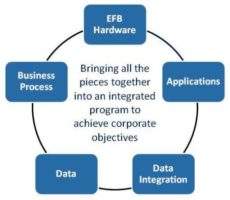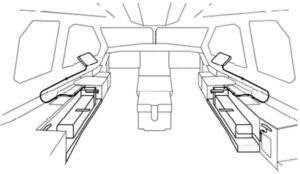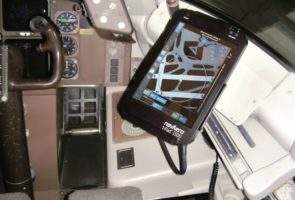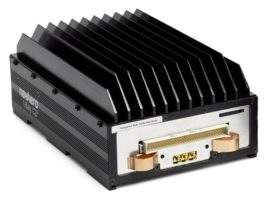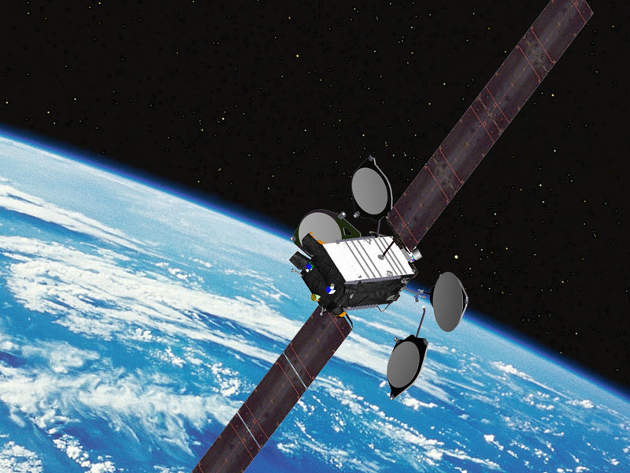navAero Electronic Flight Bag Technology for the Aviation Industry

Since our inception in 2003, navAero has been the leader in developing electronic flight bag (EFB) technology and has played a major role in helping the aviation industry define the standards and desired architectures for EFB hardware.
Beyond simply offering EFB hardware solutions, navAero provides consultative help to airline operators to aid them in working through the myriad of issues to bring all the elements together which enables an integrated EFB program to come to realisation.
Compact modular systems for the aviation industry
The navAero t.Bag™ C2² is a small, compact, low-cost modular system that has been purposefully designed and built specifically for use in airplanes. It has been manufactured to meet the rigorous requirements for business, commercial and military aircraft installations. All components meet or exceed aerospace industry standards and are certified to all applicable RTCA / DO-160 levels to insure high reliability.
The t.Bag™ C2² is the first EFB product that took into account the need for hardware to be modular in design and flexible in structure that will allow for installation on virtually all flight decks, from transport and military aircraft to business aviation. This innovative design approach of the t.Bag™ C2² system allows the computer to be remotely mounted in locations that have been previously unused / unusable.
The thin, lightweight design of any of the numerous t.Pad™ display panels allows it to be mounted on the window frame assembly, which keeps the positioning up high and in the normal scan area. The brightness controls allow the pilot to adjust the screen illumination for optimal use in all lighting conditions, from bright sunlight to night time operations.
Upgradable modular systems for airplanes
Since computer technology evolves on a regular basis, we need to consider the upgradability of the EFB CPU. The modular design of the navAero t.Bag™ C2² CPU module allows this component to be treated as an LRU that can be easily removed for upgrading as technology demands. This can all be done with no change in form / fit so there is no change in the installation structure and no impact to the certification / approvals.
Aircraft interface device
To ensure non-interference with the aircraft from commercial-off-the-shelf (COTS) software (e.g. Microsoft Windows) navAero has developed an aircraft interface device (AID) to provide a secure link to the aircraft. The AID hosts physical protection and isolation to ensure non-interference of attached data buses.
The AID ensures that EFB-hosted applications can access the ARINC 429 data bus. This is done in order to populate the software and provide information from transmitting avionics systems (e.g. FMS, IRS). This is accomplished by software developers implementing call functions via simple text avionics protocol (STAP) within the EFB application requesting the desired data. The AID is fully compliant with DO-160F requirements.
Communications interface device
For certified communication links, navAero has developed a communications interface device (CID) to provide ARINC, Ethernet and discrete connectivity for various communications protocols.
The CID is a compact, robust class 2 EFB add-on component that provides a simple and direct way for EFB operators to gain connectivity to onboard systems such as ACARS and printers. It also allows operators to achieve ARINC 615 data loading capability.
Cabin and cargo compartment video surveillance systems
In today’s security conscious world, commercial airline operators need technology solutions that allow them to have a complete view of what is happening beyond the cockpit door. To meet this need, navAero has developed the t.Cam™ cabin and cargo compartment video surveillance system.
This system employs high-resolution video cameras in combination with specially developed EFB-deployed software to capture and record images from all installed cameras. The architecture of the system is extremely simple, as the interface of the cameras routes directly to the EFB system via simply Ethernet connections.
For more information on navAero and all our technology solutions, please contact us today.
Products and Services
Video
White Papers
Press Release
navAero announced today the contract signing with Croatia Airlines for the deployment of the navAero tablet EFB system for the airline's A319/320 and Q400 fleets.
Read morenavAero announces the achievement of FAA supplemental-type certification on the Bombardier DHC-8-400 series for the installation of a class two tablet electronic flight bag provisions for the navAero tablet EFB system that includes the navAero universal interface device (UAID). Provisions include pilot / first officer cockpit mounts that feature electrical connectivitely for device charging and data connectivity.
Read morenavAero announces the succesful completion of RTCA DO160 section G testing for electromagnetic interference and rapid decompression on fourth generation iPad tablet computers.
Read morenavAero is pleased to announce the t.Bag™C22 electronic flight bag system has been awarded an EASA supplementary type certificate (STC) 10040961 for Airbus A30 and A310 series aircrafts.
Read morenavAero has announced that the t.Bag™C2² Electronic Flight Bag System has been awarded an EASA Supplementary Type Certificate (STC) 10037255 for Airbus A330-200/200F/300 series aircraft.
Read morenavAero announced today acceptance of the signed contract from Air France for supplying the t.BagC22 Electronic Flight Bag computer and display system hardware and technology / engineering services to fulfil the requirements of the Air France 'New Generation EFB' program.
Read moreRegional Offices
100 North Biscayne Boulevard, Suite 1400
Miami
Florida 33132
United States of America
Förrådsgatan 4, 856 33
Sundsvall
Sweden


